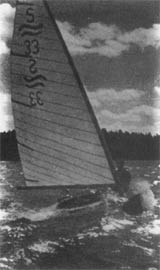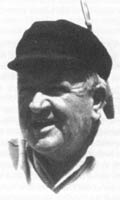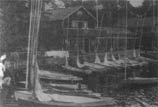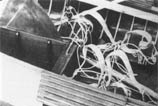| 8. History of the International Finn Association |
by Peter Mohilla and Robert Deaves |
|
It is not easy to handle the different aspects of the history of the Finn. There are many different points of view upon the subject. It is possible to sort out some of them and to cover them in special chapters, like the technical development or the history of the most important regattas. However the administrative aspect turned out to be most central and interrelated with all other matters. It reflects in detail the motivation of the leading people in the Finn Class. Therefore this chapter might bear the subtitle of 'General History of the Finn'.
|
Also there were controversial periods in the history of the IFA. Different people had differing motivations for activities on behalf of the Class. It is understandable that these different people had and partly still have contradicting opinions about the subject matters at stake. Questionable viewpoints are therefore recorded in regard with the authors. The reader has to make up his own mind about these hot issues.
1950
In 1950, Rickard Sarby handed over all the rights of the 'FIN', 'FINT', 'FLINT', 'FINN' design to the Finnish Yachting Association. As the organiser of the Olympic regatta the Finnish Yachting Association published the plans and written description of the dinghy. In mid-1950 the Scandinavian Yachting Union adopted the Finn as a Scandinavian Monotype, but did not yet take over the administration of the Finn.
|
 |
| The Swedish sailing in the Nordics with reefed sails |
|
Rickard Sarby felt burdened by the responsibility of being the designer of the Olympic monotype for 1952, and was afraid that his dinghy might turn out to be a similar failure as the 1948 'Firefly'. In a letter, Sarby wrote that he was not eager to become the designer of an Olympic dinghy. He would prefer to keep up friendships with all his friends from the 1948 Olympic Games in Torquay. Rickard was afraid it would not be possible to create a dinghy that would be accepted by all the Europeans.
|
 |
1951
As a preparation for the 1952 Olympic Games a number of nations had asked for the plans and description of the Finn. In Germany 9 boats were built, which were strongly rejected by the majority of the former 1936 O-Jolle sailors.
In the UK Vernon Stratton, the later President of the IFA, Richard Creagh-Osborne, the later Chairman of the Technical Committee, and Charles Currey, the later Silver Medalist of 1952 had the first private Finns built. France built 5 Finns, Holland 5, Belgium 2, Austria 2. In Denmark Paul Elvstrom had his 'Bess' built, in order to compete in the first International Finn Regatta, the 1951 Nordic Championship. In a letter to a friend in South Africa (where the first Finns were also built as early as 1951), Rickard Sarby complained bitterly about the rough and unfair sailing technique of that Danish hotshot. Sarby won that event but Elvstrom eliminated two other competitors for second place by sudden tacks from port to starboard and causing collisions without warning. In those days windows in the sails were not allowed, so it was easy to allure your opponents into that trap. |
 |
| In order to promote the Finn, Rickard Sarby exhibited his boat in Uppsala |
The first three Finns built privately in the UK in 1951 |
|
In the fifties Sarby was against any self bailing equipment. He felt that sailing dry was part of the game, and if you capsize it should be the end of that particular race.
1952
For the first time the Finn was the Olympic monotype. The races in Helsinki dominated the season completely. A number of nations had built or bought some Finn dinghies in order to give their top single handed helmsmen from other classes an opportunity to become familiar with this boat. Because of certain initial shortcomings of the Finn in those days many sailors rejected the Finn and predicted only a short life for the class. In light air the primitive arrangement of the wooden mast on the wooden hog and the wooden boom in the mast slot caused a squeaking noise revealing every manoeuvre. In heavy air every newcomer took his lessons on the reaches and runs with sudden death rolls to windward.
|
 |
Some even capsized when entering the Finn for the first time because Sarby had not included a word about the trick of how to get past the mast.
In contrast, Paul Elvstrom took a positive approach towards the peculiar characteristics of the Finn. He spent many hours in his boat practising, found out about his and her limits, and developed many new ideas to overcome shortcomings. This experience was the basis of his success at the Olympics. He attached hiking straps which allowed him to keep his boat more upright. While the Finns in Germany and England had the sheet attached to a horse at the transom - limiting the boom - Paul invented a short traveller on top of the thwart, which allowed him to keep his boom down and farther out.
|
|
Spectacular beaching in Forte Dei Marmi |
He went faster and pointed higher. He invented, improved and perfected the hiking and sailing technique which is customary nowadays in the Finn, not sitting on the sidedecks but hiking on the gunwale. But not only did he train hard to sail fast he also practised to keep his boat stationary at the favoured starboard end of the starting line which gave him a definite advantage at the start.
|
|
One of the Swedish Finns built in 1951 |
|
1953
After the 1952 Olympics interest in the Finn diminished in some countries. However in 1953 it was agreed between the IYRU and the Australian organisers of the 1956 Olympics, that the Finn would remain the monotype for Melbourne. In 1953 the Finnish Yachting Association handed over the administration of the Finn to the Scandinavian Yachting Union. The only international race of importance for the Finn in 1953 was the Scandinavian Championship in Oslo, won by Elvstrom with Rickard Sarby second. In the Scandinavian countries, in Holland and Belgium, and partly in France, South Africa and the UK the Finn remained alive and increased.
Charles Currey and Rickard Sarby acted as technical advisors to the Australian organisers of the 1956 Olympics. Some interesting considerations were not translated into reality at that time. Buoyancy bags and any self-bailing devices were refused, because it was accepted that a capsize should end the race. A reduction of the sail area to 9 or even 8 m2 was not adopted. However kicking straps were refused as well, since it would have prevented reefing, frequently used in heavy air in the early days.
|
 |
Henri Leten, the driving force behind
the formation of the IFA, Secretary
1956-1957, President 1957-1960 |
|
Currey suggested and Sarby approved to move the centreboard bolt further aft but finally the Olympic Finns were built in accordance with the original plans. The Australian Yachting Federation requested permission to build the Olympic Finns in fibre glass construction, however the Scandinavian Yachting Union denied approval.
|
 |
In November 1953 the IYRU agreed that it would be very desirable to retain the Finn Class as a single-handed class in Olympic regattas for some time. It was agreed that the grant of international status to the Finn Class would be favourably considered if a request for it was received at some time. The addressee of that message was the Scandinavian Yachting Union. However that body remained inactive to the disadvantage of the Finn Class.
|
 |
| The international fleet gathering at Rickard Sarby's home club in Uppsala |
Paul Elvstrom's Bess |
|
1954
As a preparation for the 1956 Olympics the Dutch Sailing Federation heavily subsidised the construction of Finn Dinghies in 1954. Aside from Sweden, Belgium became the centre of Finn activities with French, British and Dutch participants in the international race at Zeebrugge. The 9 existing German Finns were not used in 1954.
Some new countries were interested in starting Finn sailing. However the development was handicapped by the fact, that the Scandinavian Yachting Union administered the Class. Requests for the delivery of building plans and instructions were answered very late or never. The problem with the Scandinavian Yachting Union was, that English is not the official language and that the administration rotates every other year between the four Scandinavian countries. Only the fact that it was decided that the Finn was to be the Olympic monotype for 1956 kept the Class alive. |
|